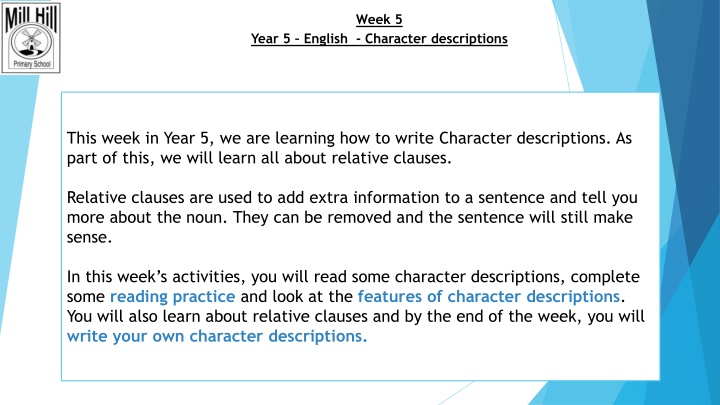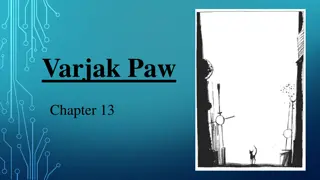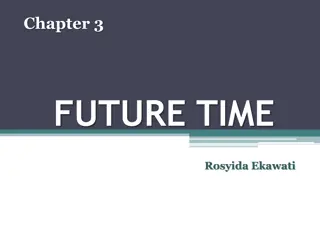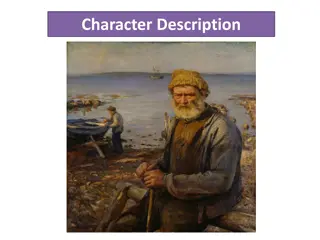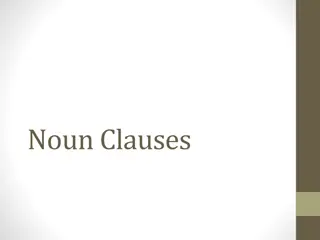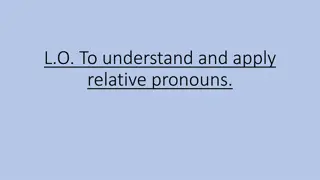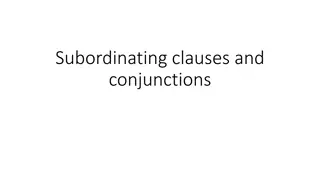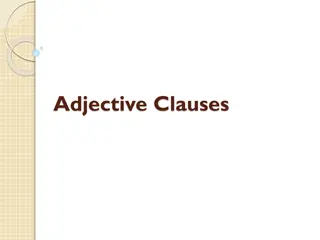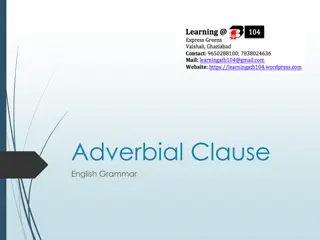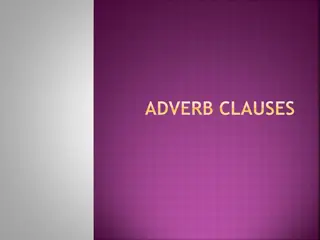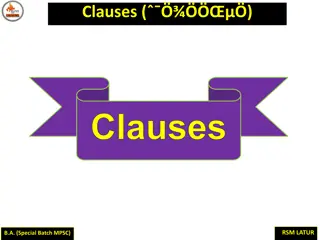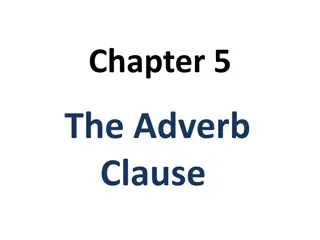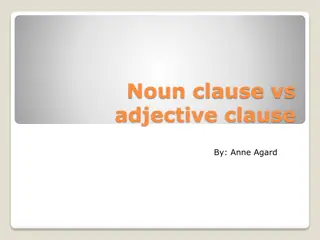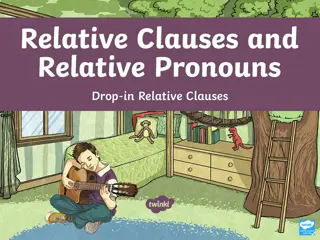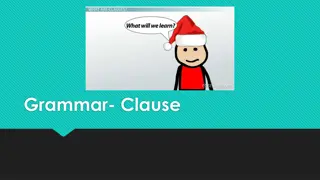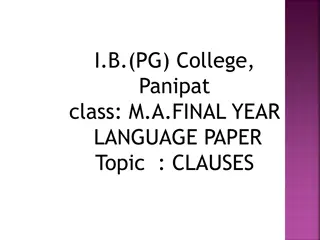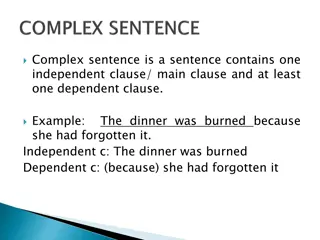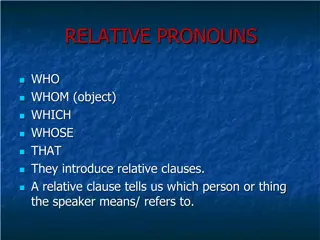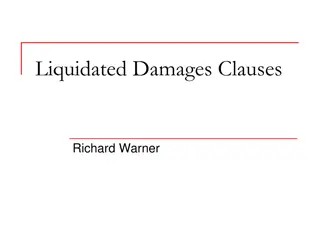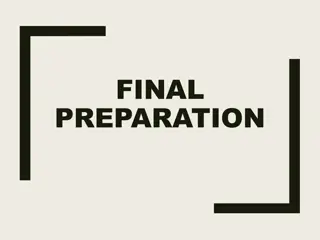Writing Character Descriptions & Relative Clauses
This week in Year 5, students learn to write character descriptions and explore relative clauses. The activities include reading comprehension, word meanings, and SPaG focus to enhance writing skills. Students will watch teaching videos, complete activities, quizzes, and challenge sheets. Practicing spellings is also encouraged for a comprehensive learning experience.
Download Presentation

Please find below an Image/Link to download the presentation.
The content on the website is provided AS IS for your information and personal use only. It may not be sold, licensed, or shared on other websites without obtaining consent from the author.If you encounter any issues during the download, it is possible that the publisher has removed the file from their server.
You are allowed to download the files provided on this website for personal or commercial use, subject to the condition that they are used lawfully. All files are the property of their respective owners.
The content on the website is provided AS IS for your information and personal use only. It may not be sold, licensed, or shared on other websites without obtaining consent from the author.
E N D
Presentation Transcript
Week 5 Year 5 English - Character descriptions This week in Year 5, we are learning how to write Character descriptions. As part of this, we will learn all about relative clauses. Relative clauses are used to add extra information to a sentence and tell you more about the noun. They can be removed and the sentence will still make sense. In this week s activities, you will read some character descriptions, complete some reading practice and look at the features of character descriptions. You will also learn about relative clauses and by the end of the week, you will write your own character descriptions.
Relative Clause Sentences We can add extra additional detail about a noun by adding a relative clause to a sentence. Instead of using two single-clause (simple sentences) to describe something, e.g. Sarah is eating roast chicken. It is her favourite meal. We can combine the two sentences to make one multi-clause (complex) sentence using subordination with a relative clause. e.g. Sarah is eating spaghetti, which is her favourite meal. A relative clause is connected to the main clause by a relative pronoun. We ve replaced the pronoun It in the second sentence with the relative pronoun which .
Relative clauses always start with a relative pronoun. These are words like which, who, where, when and that.
Week 5 Year 5 Character descriptions On the following page you will find a link to follow each day. 1. On each link, you will find a 15 minute teaching video - make sure that you have a pen and paper ready in case you are asked to write anything down. 2. After watching the video, click Next to turn to the following page and bring up an activity which you can complete online or print off. 3. Before finishing the work, test your knowledge by completing the quiz. 4. At the end of the week, come back to this PowerPoint and try the challenge sheets, Speedy SPAG at the end of this PowerPoint to see how much you have remembered. Spellings: Don t forget to practise your spellings each day at the end of each activity. To do this, you could choose a spelling task from the spelling slides!
Week 5 Year 5 Character descriptions Monday - Character Description: Reading Comprehension - Fact Retrieval https://classroom.thenational.academy/lessons/character-description-reading-comprehension-fact- retrieval Tuesday Character Description: Reading Comprehension - Word Meaning https://classroom.thenational.academy/lessons/character-description-reading-comprehension-word- meaning Wednesday https://classroom.thenational.academy/lessons/character-description-write-a- character-description Thursday Character Description: SPaG focus - Relative Clause https://classroom.thenational.academy/lessons/character-description-spag-focus-relative-clause Friday Character Description: Write a character description https://classroom.thenational.academy/lessons/character-description-write-a-character-description SPAG Challenge sheets To test what you have learnt, complete the Speedy SPAG sheet and then mark your own work. Also, try some of the other SPAG challenges which you can find at the end of this PowerPoint.
Spellings Why not try one of the spelling tasks on the next pages to help you learn your spellings?
Spelling activities Definitions Use a paper or online dictionary to find out the meaning of each of your spelling words can you write your own definition in your own words to explain what it means ? Sentences Write a sentence for each of your spellings. Challenge: Can you include this week s SPAG focus in one of your sentences?
Spelling activities Look, say, cover, write, check Can you practise learning your spellings using look, say, cover, write, check? Look at the word. Say it aloud a few times. Cover it up with a piece of paper or your hand. Write the spelling next to the original word. Check your version to see if you got it right.
Spelling activities Mnemonics Can you make up your own mnemonic to help you remember your most difficult spelling? A mnemonic is a tool that helps you to remember something they are great for tricky spellings! Here s a great video which explains how they work . https://www.youtube.com/watch?v=AcUoW1ek5zU
Spelling activities Spelling Pyramid Use this template (or create your own on paper) and order your spellings from easiest to hardest. Write the easiest spelling at the top and the hardest at the bottom, you will need to write each word several times to fill the entire line.
Week 5 Year 5 Speedy SPAG My new kitten, which we called Juno, is scratching our leather sofa. Mum is furious! 1. Identify the relative clause. 2. Identify the relative pronoun. 3. Which verb can be changed so the sentences are written in the past tense? 4. Write two synonyms of furious. A synonym is a word that means the same as another.
Week 5 Year 5 Speedy SPAG Click onto the next page to see the answers
Week 5 Year 5 Speedy SPAG answers My new kitten, which we called Juno, is scratching our leather sofa. Mum is furious! 1. which we called Juno 2. which 3. My new kitten, which we called Juno, was scratching our leather sofa. Mum is furious! 4. Various possibilities: mad, fuming, livid, raging etc
Can you find the relative clause in each sentence and underline the relative pronoun?
